





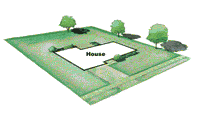 From bare lot to showcase yard inthree years.
From bare lot to showcase yard inthree years.
Whether you are starting from scratch with a new house and a builder's landscape job, or just want to renovate your existing yard, it will pay you to plan carefully and stage your project over several years. This three-year plan may not work for your needs, but it illustrates some key planning points to keep in mind as you develop your own ideas.
Related Feature: Home Landscaping 101
continue reading below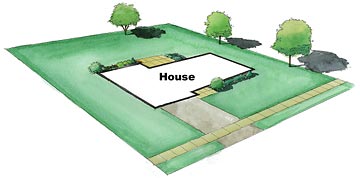
Our sample yard starts out with little more than a few trees and shrubs. There is only the inkling of an entry landscape, and the rear patio is minimal. There is also no privacy in the backyard, few shady areas for relaxation, and no amenities to tempt you or your guests into the yard.
Let's follow these homeowners as they address these, and other, shortcomings.
Related Feature: Assessing Your Landscape Needs
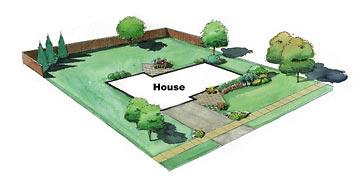 Some key hardscape improvementsand new trees are the key changesin year one.
Some key hardscape improvementsand new trees are the key changesin year one.
Year one's plan starts with the removal of any overgrown and unwanted plants. This is also the time to solve problems with drainage and poor soil. Salvage as much as you can from your existing landscaping -- like the three shade trees saved here -- but don't be afraid to remove plants that don't fit your plans.
Because their installation can cause damage to surrounding plants, major hardscape additions should be made early on. This especially includes large-scale projects like fences, decks, and patios.
Related Feature: Putting Your Landscape Plan into Action
Even modest-sized trees are expensive, so it pays to plant them early in your landscape renovation. Smaller trees are also better able to adapt to the shock of being moved. For a more interesting design, plan on a mix of deciduous and evergreen varieties.
Related Feature: Assessing the Value of Trees and Shrubs
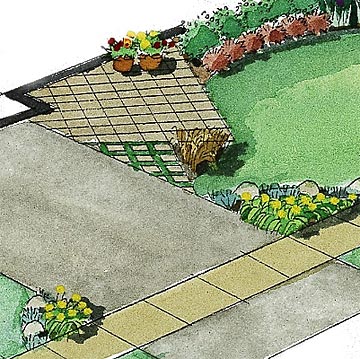
Enhanced entry. Simple changes to the front entry, such as a friendly design and high-quality paving materials, increase your home's curb appeal.
Curb appeal. Small flowerbeds at the foot of the driveway add a welcoming feel and pleasantly enhance your yard's overall impression.
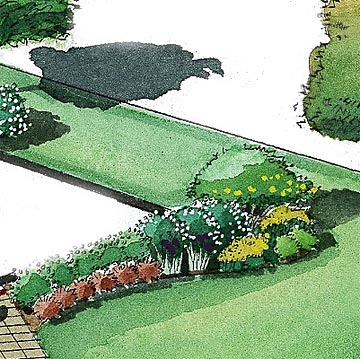
Front foundation plantings. Plantings close to the house provide a transition between your home and the surrounding landscape. For maximum interest, incorporate a variety of plants in an irregular configuration. In cold areas, include some evergreen plants to provide winter interest.
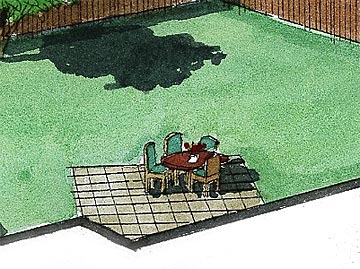
Enlarged back patio. Install a patio at the back of the house to offer space for grilling, outdoor dining, and other activities. To decide how large the patio should be, consider the number of people who will be using this space on a regular basis.
Related Feature: Estimating Space for Outdoor Entertaining
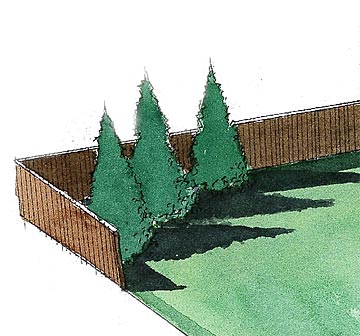
Privacy features. A backyard that is shielded from outside eyes is always more alluring. In this example, we installed a board fence along the rear and side lot lines. New evergreen trees help soften the corner and further increase privacy.
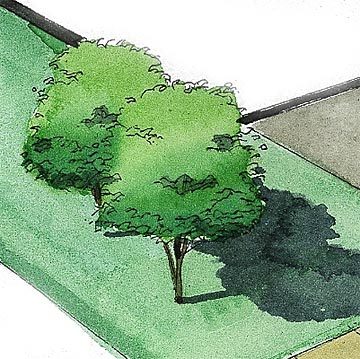
Shade trees. Buy the largest trees your budget allows. Well-placed trees add value to your property, and help conserve energy by shading your home.
Find even more home landscaping tips and ideas.

With the "must have" stuff out of the way, year two is the time to starting adding the "love to have" features. In this case, those include more extensive shrubs and flowerbeds, an expanded patio, and the piece-de-resistance, a pavilion-shaded spa.
When planning your plantings, be sure to consider the amount of maintenance you want to be saddled with. Many shrubs are well-behaved and require minimal pruning and preening, while most perennials and other flowers require at least a bit more work. Work with a trusted nursery or garden center to select plants that match your taste and tolerance for work.
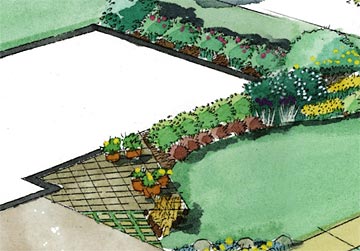
Entry upgrades. Containers of colorful annuals add season-long color, turning the entry into a focal point.
Extended foundation plantings. With the front foundation planting well-established, it's time to turn to the side foundation areas. These plantings can be simpler, but should be selected for a long season of beauty.
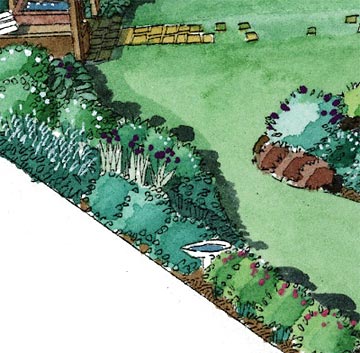
Border bed. A line of shrubs and flowers along the border of your property provides privacy with a friendlier face than a board fence. In addition, a well-planned border looks good from inside your home as well as from the outside.
For added interest, include some features like a birdbath or feeder that will attractive wildlife. For even better results, plant shrubs and flowers that will provide food and shelter for birds, butterflies, and other welcome creatures.
Related Feature: Planning a Wildlife Garden
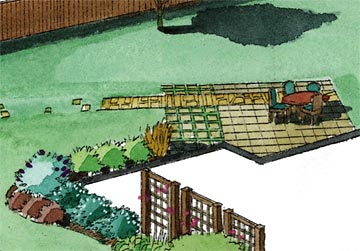
Patio expansion. As your needs change, you may want to expand outdoor living areas. Here, the patio was expanded by using the same material, but spaced to create planting pockets between the pavers. The new turf helps create a transition between patio and lawn.
Think vertical. Don't forget vines when picking the plants for your plan. In this case, decorative trellises were added near the house to soften the bare walls and to provide support for flowering vines.
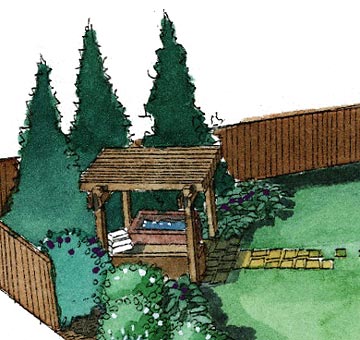
Pavilion and spa. Make a spa or other area feel like a real destination by adding a pavilion. Plant vines on it to blend it in with its surroundings, or leave it bare for a stronger architectural statement.
Pathways. Paths help break up an expanse of lawn and direct the eye to destination points. In this case, the path leading from the pavilion points directly to the patio, even though it peters out after a few yards. A similar path at the patio directs visitors toward the pavilion.
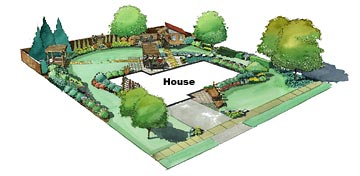
Year three is a good time to start adding luxury touches to your landscape. The pergola over the patio and the attractive shed are just two of the improvements to this yard.
You might choose features like a fountain or pond, an outdoor fireplace, or a private retreat tucked away in the back of the yard. Whatever you choose, you'll be glad that you took care of the most important features in the previous years.
This is also the time to go back and evaluate some of the installations you made previously. You might decide to soften the look of a fence with a vine or line of shrubs. Or you may want to fill in with more planting beds.

Enhancing the entry. Incorporating a bench near the entry adds a welcoming touch to visitors and family alike. To further dramatize this area, the design incorporates bollard lighting, which provides a soft glow in the evening.
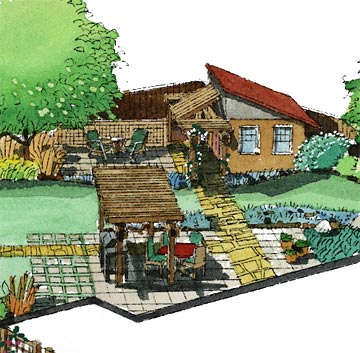
Upgrades for outdoor living. Shade is always at a premium when landscaping is young. A new pergola over the patio adds days of usefulness that might otherwise be too hot for pleasant outdoor entertaining. This view also shows how the patio was expanded to the corner of the lot, which now includes a small seating area and an attractive shed.
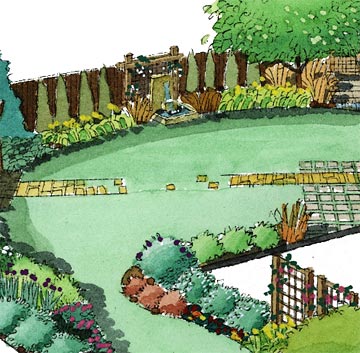
Attention to details. The plain board fence gets a makeover this year. Tall evergreen shrubs soften the hard face of the fence, and a new fountain creates a focal point framed by attractive flowerbeds. In addition to adding a new sight, the fountain adds sound, which can help mask noise from nearby yards and streets.
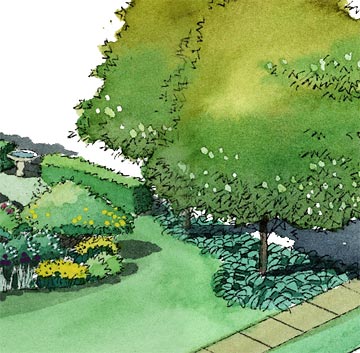
Reducing maintenance. Shade trees offer welcome relief from sun and wind, but they also create maintenance headaches. Mowing and trimming around the trunks can be reduced by underplanting trees with shade-loving perennials. Here, large-leaved hostas provide a rugged, weed-blocking ground cover that looks good from spring through late fall.
Plant a hedge. Like fences, hedges perform several useful roles. They define space, improve privacy, and provide an attractive frame for the house and yard. This low hedge is easy to maintain and provides year-round interest.
Related Features: Yard Makeovers
Related Features: Outdoor Rooms
Copyright © www.100flowers.win Botanic Garden All Rights Reserved